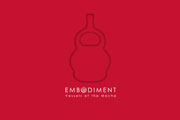

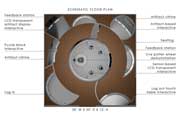 An overarching layer of data ties together three main threads of the thesis — language, media, and millennials. Using a 3D-printed miniature replica of a Moche vessel, visitors are able to scan artifact display labels to curate their own digital collection and then provide feedback on the objects in the form of hashtags.
An overarching layer of data ties together three main threads of the thesis — language, media, and millennials. Using a 3D-printed miniature replica of a Moche vessel, visitors are able to scan artifact display labels to curate their own digital collection and then provide feedback on the objects in the form of hashtags.
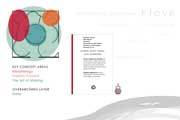 Moche Avatar: An online pre-visit survey matches visitors to a custom Moche Avatar. As
Moche Avatar: An online pre-visit survey matches visitors to a custom Moche Avatar. As they arrive, visitors log in and activate their 3D-printed vessel replicas linked to their
personalized Avatar. As visitors are oriented to the hashtag feedback process, they see
a projection of the exhibit's trending hashtags and accompanying vessel artifacts.
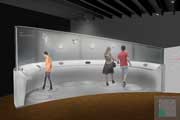 Morphology: Among traditional vitrine displays, visitors learn about the physicality of
Morphology: Among traditional vitrine displays, visitors learn about the physicality of vessels as they engage in a puzzle block interactive that explores comparisons of the
human anatomy and the anatomy of a vessel. Through gestural actions, visitors activate
a LCD transparent display to show information overlayed in front of the actual artifact.
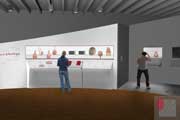 Express Yourself: Visitors engage in digital interactive games that teach them about the
Express Yourself: Visitors engage in digital interactive games that teach them about the Moche's use of symbolic communication and record keeping in place of a written
language. The activities have the spirit of popular games such as Pictionary and I Spy.
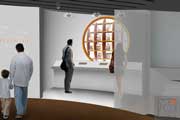 Express Yourself game storyboard: This is a two-part interactive — telling a story with symbols and then matching a vessel to a previously submitted symbol story created by other visitors.
Express Yourself game storyboard: This is a two-part interactive — telling a story with symbols and then matching a vessel to a previously submitted symbol story created by other visitors.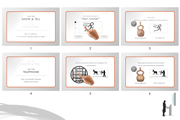 The Art of Making exterior view
The Art of Making exterior view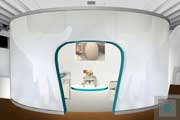 The Art of Making interior view: Visitors witness a professional local potter throwing
The Art of Making interior view: Visitors witness a professional local potter throwing clay on a wheel. Visitors also learn about different pottery making methods with a
hands-on interactive that digitally simulates the experience of creating pottery.
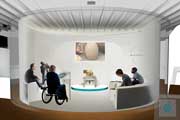 The Art of Making digital interactive storyboard: Using a combination of a multitouch LCD transparent screen and motion sensor technology, visitors shape a digital mound of clay and explore creativity in an engaging, modern way.
The Art of Making digital interactive storyboard: Using a combination of a multitouch LCD transparent screen and motion sensor technology, visitors shape a digital mound of clay and explore creativity in an engaging, modern way.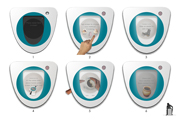 Make Yourself: Visitors build upon or completely change the initial Moche Avatar they
Make Yourself: Visitors build upon or completely change the initial Moche Avatar they were assigned. They can use data they collected throughout the exhibition and can also
borrow elements others have created. Visitors are prompted to share their activity
from the exhibition on their social media channels, a modern-day form of communication.
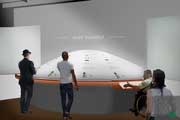 Graphic Approach: Design choices aim to convey the spirit of the subject rather than a literal depiction. Positive-negative relationships present in Moche vessel fine-line paintings are interpreted into graphics that blur the lines between vessel and human attributes. The sleek, simple design punctuated by pops of color coincides with qualities of the new media language outlined by my thesis.
Graphic Approach: Design choices aim to convey the spirit of the subject rather than a literal depiction. Positive-negative relationships present in Moche vessel fine-line paintings are interpreted into graphics that blur the lines between vessel and human attributes. The sleek, simple design punctuated by pops of color coincides with qualities of the new media language outlined by my thesis.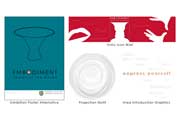 Exhibit Entry Icon Model
Exhibit Entry Icon Model
EMBODIMENT:
VESSELS OF THE MOCHE
MUSEUM EXHIBITION DESIGN
Role
- Concept development
- Thesis development
- Design development
- Exhibition identity/branding
- Media content development/design
Objective
Create an exhibition about Moche pottery vessels that will prove an original thesis
Client
Center for the Future of Museums (American Alliance of Museums initiative)
Location
Memorial Art Gallery, Rochester, NY
Primary Audience
Millennials
Graduate thesis project
Thesis Statement
By examining George E. Hein's principle of how language affects learning, exhibitions will modernize museum constructivist learning techniques by using the nature of the language of new media as a vehicle for communication. This will allow museums to better respond to the evolved needs of a twenty-first-century audience, particularly millennials.